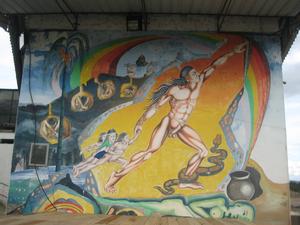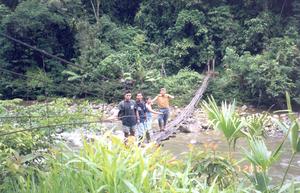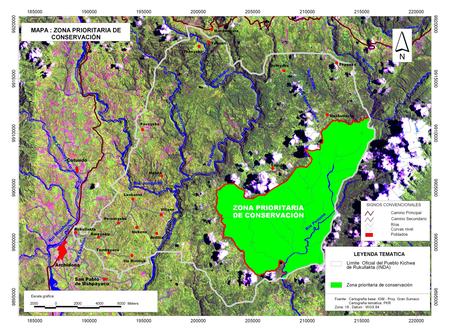As indigenous peoples in Latin America increasingly gain title to collective territories, they enjoy a new degree of security in terms of their future access to land. They also face new challenges. The residents of indigenous territories are expected by outsiders to act as a unified political entity, almost like a small nation-state. They must collectively negotiate relationships with external entities spanning national ministries and a wide variety of NGOs to international corporations wanting to exploit natural resources within their collective land title. These negotiations often require creating and enforcing internal policies regarding what can and cannot be done within their borders. Carrying out these governance tasks is expensive, at the very minimum involving sustaining the infrastructure for communicating with the outside world and with residents living across sometimes vast areas.
Yet, as Richard Stahler-Sholk argued in the NACLA Report, most indigenous territories have been granted “autonomy without resources.”1 Often unable to tax or collect annual dues from their residents, the leaders of indigenous territories must seek funds to support their governance tasks by working with outsiders. The need for money often pushes them into collaborative development activities with NGOs, government ministries, and even corporations. Ironically, then, territorial titling—presumably pursued as a way to allow indigenous peoples to continue traditional livelihoods—often pressures residents into new entanglements with capital, state bureaucracies, and foreign organizations.

Savvy indigenous leaders must therefore continually assess development trends and determine whether programs associated with these trends present opportunities or threats to their constituents. Contrary to what many non-indigenous people expect, indigenous leaders often sharply disagree with one another on their assessments, spurring heated controversies within and among indigenous federations. One particularly heated controversy revolves around Reducing Emissions From Deforestation and Degradation (REDD), one of the United Nations’ central programs in combating carbon emissions, under which polluters can offset their emissions by purchasing carbon credits generated by governments, companies, and communities that protect forests. The program has its origins in the 2005 meeting of the UN Framework Convention on Climate Change, during which the Coalition for Rainforest Nations proposed that there be incentives for countries to control emissions by reducing deforestation. Their proposal evolved into REDD.2 Over time, international development planners started speaking of REDD+, with the plus sign intended to highlight the enhancement of carbon stocks that could be made through sustainable forest management (rather than simply forest protection) and the importance of paying attention to the needs of local communities.
For example, the UN webpage devoted to describing REDD+ explains: “It is predicted that financial flows for greenhouse gas emission reductions from REDD+ could reach up to US$30 billion a year. This significant North-South flow of funds could reward a meaningful reduction of carbon emissions and could also support new, pro-poor development, help conserve biodiversity and secure vital ecosystem services. Further, maintaining forest ecosystems can contribute to increased resilience to climate change. To achieve these multiple benefits, REDD+ will require the full engagement and respect for the rights of Indigenous Peoples and other forest-dependent communities.”3
Although the United Nations portrays the program as a clear win-win situation, many indigenous rights organizations fear that it will lead to land grabs or other threats to their sovereignty. Indeed, so-called carbon cowboys have persuaded some indigenous communities to sign over control of their territories in exchange for promises of carbon monies.4 The International Indigenous Peoples Forum on Climate Change has taken a strong stance against REDD, arguing that “REDD/REDD+ will not benefit Indigenous Peoples, but in fact will result in more violations of Indigenous Peoples’ rights. It will increase the violation of our human rights, our rights to our lands, territories and resources, steal our land, cause forced evictions, prevent access and threaten indigenous agricultural practices, destroy biodiversity and cultural diversity, and cause social conflicts.”5
Taking a dramatically different view of REDD, the Confederation of Indigenous Organizations of the Amazon (COICA), a transnational indigenous rights organization coordinating efforts by indigenous federations in nine Amazonian nations, has taken a generally pro-REDD stance and entered into multiple partnerships associated with REDD monies. Their first REDD-associated project was a collaboration with the U.S.-based Environmental Defense Fund (EDF) and Woods Hole Research Center, through which members of indigenous communities in the Ecuadoran Amazon were trained to measure carbon storage potential in standing forests. A blog maintained by Chris Meyer, project coordinator of the Amazon Basin for EDF, includes the following statement concerning EDF’s collaborative work with COICA:
Instead of having outsiders come in and measure the carbon in the community’s trees, indigenous communities can measure it themselves, earn good wages, and learn to value another resource in their forests: carbon. . . . The training workshop, which has been adapted for numerous other indigenous groups in the Amazon Basin, teaches and empowers indigenous people with technical skills needed for measuring carbon trapped in forests, like using a GPS to find specific coordinates; measuring out a 40 x 40 meter “parcel” of forest; and measuring the diameter of each tree in that area . . . indigenous peoples with forest carbon measuring skills will be able to generate not only good jobs for locals based on conservation, but also generate important information regarding the amount of carbon in their lands that will help them make better land management—and conservation—decisions for the future.6
Thus, in entering this project, COICA tapped into international concerns about the environment to obtain benefits for indigenous communities—in this case, opportunities for training in forest inventory skills and short-term salaried work for participants. Through their collaboration with EDF, COICA’s leaders played an important role in shaping the program into something that they believed would include their priorities, particularly creating jobs and training opportunities. Once the agreements were drafted, the leaders evaluated them as having benefits that outweighed the risks involved, including the risk that environmental and multilateral development organizations were attempting to take control of the lands in indigenous territories.

The Ecuadoran government has also identified REDD as potentially beneficial and initiated its own programs to demonstrate that it is REDD-ready. In particular, it began a program called Socio Bosque (Partner Forest), in which private or collective owners of forested land can voluntarily join the program, committing to conserve the forest within a defined reserve on their land for a period of 20 years. In exchange, forest owners receive a payment from the Ministry of Environment payments beginning at $30 per hectare, with reserves over 50 hectares receiving less per hectare as the size of the reserve increases. If landowners break the stipulations of the contract, they must return all or part of the money they had received until that point, with the fraction decreasing over time.7 According to one indigenous participant, breaking his territory’s contract within five years of signing it would require returning all of the money received; within the first 10 years, half of it; and within the first 15 years, 25%. It is not clear what the Ministry of Environment would do if program participants broke the contract and were unable to pay the fine.
Both COICA’s early programs and the Socio Bosque governmental initiative led the Confederation of Indigenous Nationalities of the Ecuadorian Amazon (CONFENIAE)—one of COICA’s nine member organizations—to draft a formal denunciation of REDD initiatives in 2009. The denunciation was distributed to multiple Northern NGOs, as well as other concerned groups and individuals. (See “CONFENIAE’s Denunciation of REDD Initiatives,” page 57.8)
CONFENIAE’s statement frequently compares REDD and its implications to petroleum extraction and mining. By drawing that stark comparison, CONFENIAE’s representatives are expressing their fear that participating in agreements such as REDD is analogous to signing over the titles to their territories, allowing environmentalists and carbon traders to gain control of the areas whose legal titles they fought so hard to obtain. The statement was a very public attack against COICA, an organization to which it belongs and which is currently headquartered in nearby Quito, Ecuador (about a six-hour drive from CONFENIAE’s headquarters).
Despite CONFENIAE’s harsh assessment, COICA continued its collaboration with EDF and subsequently signed an additional REDD agreement with the Inter-American Development Bank (IDB) on April 20, 2011, to pursue a series of activities in the Amazon Basin. Like the initial project pursued by COICA with EDF, the agreement that COICA made with the IDB highlights training and jobs for indigenous people over simply being paid not to use the land. Once again, COICA was able to insert some of its priorities into the collaborative projects. The COICA website went into great detail about how Component 1 of the IDB project involved educating indigenous people about REDD and training them in forest-management skills such as measuring trees and using GPS to determine precise latitudinal and longitudinal coordinates.
Component 2 involved attending international conferences in which funders of REDD would be present. Component 3 was the pilot project component, in which “COICA, the IDB, and associated NGOs would work with indigenous communities that have participated in Component 1 [training], to identify the communities with the environment and adequate conditions (such as secure land tenure, capacity, property rights over carbon or agreements for distributing earnings, adequate carbon reserves, community support, etc.).”9 Thus, at least in the way the agreement was presented on the COICA website, many communities throughout the Amazon Basin could benefit from training in the measurement of carbon storage potential and use of a global positioning system. Only after receiving this training would they have to evaluate whether they were willing and able to enter into a carbon-trading agreement. Importantly, the forest skills that course participants learn in Component 1 enable them to engage not only in the measurement of carbon holding capacity, but also in a variety of other forest-management activities, and therefore could be potentially transferred to other jobs (including extractive activities) in the future.

The controversy between CONFENIAE and COICA is not about whether conservation is inherently good or bad, since CONFENIAE has supported a number of conservation initiatives in the past. It is a debate over what will improve the well-being of indigenous populations. COICA sees global concerns over climate change as an opportunity to obtain things most indigenous communities say that they want: job opportunities and training in skills relevant to life in their particular environment. CONFENIAE, on the other hand, denounces the REDD program as the first step on what could become a road to indigenous peoples’ territorial disenfranchisement. The CONFENIAE statement quoted above is comprehensive, criticizing any initiative in which indigenous people receive payments for the resources in their territories—be it for petroleum or for “environmental services” (a broad term that covers initiatives in which owners of natural areas are paid for the “work” that their landscapes conduct, including, for example, carbon storage by forests or the water purification that occurs in a natural wetland).
Some indigenous leaders are critical of initiatives that pay indigenous people not to work, believing that it leads to dependency and laziness. Others argue that if payments are made to the governments of indigenous territories rather than individual residents, those governments can use the funds to provide agricultural credit to residents or to initiate pilot development projects of their own design.
The controversy illustrates how indigenous autonomy is not merely and simply achieved by acquiring territorial rights but is attached to changing sets of expectations and obligations. Outsiders expect, even oblige, territorial governments to act like modern states, making decisions about whether to allow particular development projects like REDD to take place within their territory. Those who fund development projects in indigenous territories expect local leaders to ensure that residents participate wholeheartedly in their projects, following new rules and policies, providing their labor (often without pay) and showing enthusiasm for the project’s goals. If an indigenous territorial government enters an agreement to prevent deforestation on a large section of their territory, who will monitor compliance and how? Who will pay for that monitoring? While international organizations and corporations are willing to pay a certain amount for forest conservation, territorial governments are left with the more complicated task of implementing the plans and with the internal tensions caused by conflicts that may rise in the course of implementation.
In many cases, residents of indigenous territories also have high expectations of their leaders, wanting them to pursue development projects that will bring material improvements without requiring dramatic changes in the ways they work and live. Leaders must attempt to assess whether new opportunities for development collaboration meet this standard or not, often with their own reputations at stake. Given the uncertainties involved in any collaboration with outsiders and the many failures of past development initiatives, it is not surprising that disagreements flare.
The landscape of development opportunities and threats is always changing, forcing indigenous leaders to remain current in their understandings of both. In the 1970s, the international development community wanted Amazonians to cut down rainforest, plant pasture, and raise cattle, and agreeing to do so was one of the only ways those living in frontier areas could ensure continued access to land. Starting in the 1990s, the international emphasis was on biodiversity conservation, which often translated into prohibiting all uses of the forest, except ecotourism. Development projects funded under this paradigm trained indigenous people to construct tourism facilities, cook, act as tour guides, and otherwise cater to tourists’ needs. Some communities hosted a substantial number of tourists, while many others saw few visitors to the facilities they worked so hard to construct. The new emphasis on carbon storage is one that can potentially offer a new set of skills to indigenous participants: measuring trees, mapping forests, and using data acquired in measured forest plots to extrapolate to larger areas. However, their communities’ ability to earn from carbon faces similar levels of insecurity and risk as their investments in ecotourism over the last two decades.
Both the biodiversity and carbon-reduction development paradigms involved shifts in how indigenous people came to think of trees and other plants. Northern conservationists such as Chris Meyer, the EDF project coordinator quoted above, hope that by showing indigenous people that the forest can earn money when left alone will convince them that even species that previously were thought of as uninteresting deserve their active protection. Indigenous leaders and their constituents must evaluate whether these new practices and understandings are preferable to those offered by other development collaborations.
As indigenous peoples are forced into creating governance institutions that can continue to collaborate with or actively and vociferously reject what others want to do in their territories, they must form alliances; isolation is no longer an option, as money and expertise are needed to navigate an ever-changing array of threats and opportunities. While it is relatively straightforward to issue blanket denunciations as CONFENIAE has done against REDD, COICA’s efforts to shape collaborations in such a way as to achieve some indigenous priorities are riskier, with the potential to bring either benefits or loss of control over land. Those who stand to gain or lose the most, however, are not those leaders who negotiate collaborative projects from the offices of indigenous federations, but the territorial governments and residents themselves. The latter must make their own decisions as to whether or not to participate in particular programs, and ultimately live with the consequences.
1. Richard Stahler-Sholk, “Time of the Snails: Autonomy and Resistance in Chiapas,” NACLA Report on the Americas 38, no. 5. (March/April 2005): 37.
2. Autumn Spanne, “Reducing Emissions From Deforestation and Forest Degradation (REDD),” NACLA Report on the Americas 45, no. 3. (September 2012): 67.
3. UN-REDD Programme, “About REDD+,” 2009, un-redd.org/AboutREDD/tabid/582/Default
.aspx.
4. See, for example, Chris Lang, “The Carbon Cowboy: David Nilsson on 60 Minutes Australia,” July 10, 2012, available at redd-monitor.org.
5. Tom B. Goldtooth, “Why REDD/REDD+ Is Not a Solution,” quoted in Joanna Cabello and Tamra Gilbertson, No REDD! A Reader (Carbon Trade Watch, 2011), 18, available at wrm.org.uy/publications/REDDreaderEN.pdf.
6. Chris Meyer, “Ecuadorian Indigenous Community Takes Conservation Into Own Hands,” The Environmental Defense Fund Blog, October 29, 2010, available at blogs.edf.org.
7. Free de Koning et al., “Bridging the Gap Between Forest Conservation and Poverty Alleviation: The Ecuadorian Socio Bosque Program,” Environmental Science and Policy 14, no. 5. (August 2011): 531–42.
8. The full statement is available at, among other sites, redd-monitor.org.
9. These quotes previously appeared on the COICA website, coica.org.ec, under the “Noticias” (News) tab, but are no longer available there. Translated from Spanish by the author.
Juliet S. Erazo is Assistant Professor of Anthropology in the Department of Global and Sociocultural Studies at Florida International University. She is the author of Governing Indigenous Territories: Enacting Sovereignty in the Ecuadorian Amazon (Duke University Press, forthcoming).
Read the rest of NACLA's Spring 2013 issue: "The Climate Debt: Who Profits, Who Pays?"

